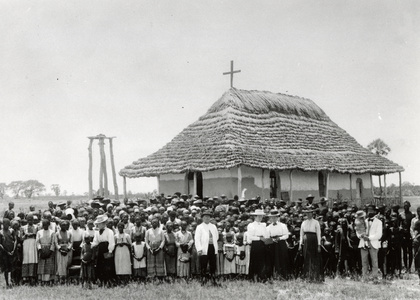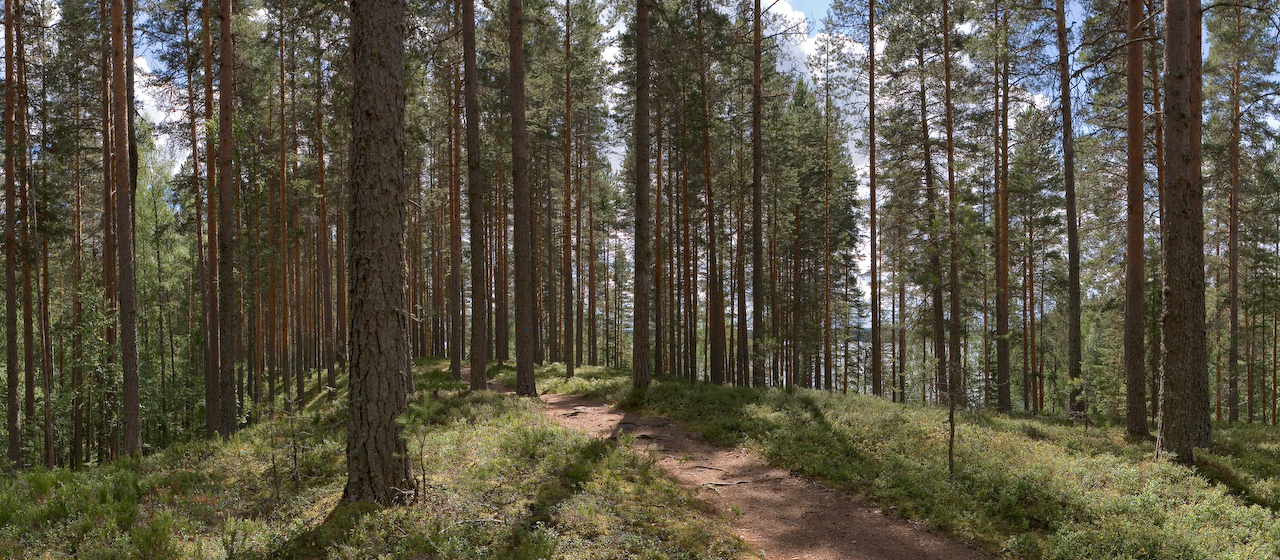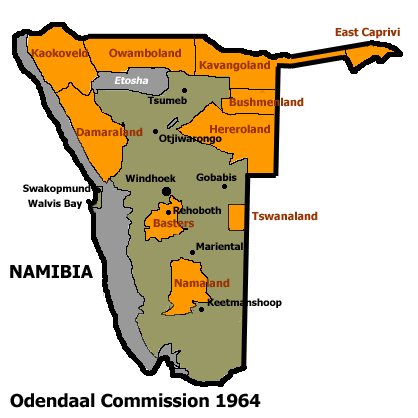|
C. G. Tötterman
Carl Gustaf Tötterman (b. June 21, 1836 Pyhäjärvi Vpl., now Otradnoye, Priozersky District, Leningrad Oblast – May 20, 1895 Helsinki) was the second director of the Finnish Missionary Society, occupying this position from 1877 until his death in 1895. Background C. G. Tötterman came from a family of clerics. His father was chaplain Claes Kristian Albert Tötterman, who worked as the acting vicar and chaplain of Pyhäjärvi (Viipuri Province) and later as chaplain of Joutsa. His mother was Gustava Fredrika Stenroth. He graduated from the Porvoo Gymnasium, and he was ordained a minister in 1860. In 1861 he married Ida Lovisa Rancken. They do not seem to have had children. Tenure in the Finnish Missionary Society Tötterman was a member of board of the mission society from 1866 on. When K. J. G. Sirelius stepped down as the director, Tötterman was elected to this position, and Remes characterises him as "a true pioneer" in this work. However, in matters dealing with activit ... [...More Info...] [...Related Items...] OR: [Wikipedia] [Google] [Baidu] |
Pyhäjärvi Vpl
Otradnoje (russian: Отра́дное; fi, Pyhäjärvi, italics=no, ''Пӱхӓјӓрві'') is a types of inhabited localities in Russia, rural locality (a settlement at the railway station) in Priozersky District of Leningrad Oblast and a railway station of the Saint Petersburg-Hiitola railway, located on the Karelian Isthmus at the western shore of Lake Otradnoye (Lake Pyhäjärvi). Before the Winter War and Continuation War, it was the administrative center of the Pyhäjärvi Municipality in Viipuri Province of Finland. It is birthplace of Juhana Toiviainen (1879–1937), Karl Lennart Oesch (1892–1978), Matti Pärssinen (1896–1951), Armas Äikiä (1904–1965) and Nestori Kaasalainen (1915–2016). Rural localities in Leningrad Oblast Karelian Isthmus {{LeningradOblast-geo-stub ... [...More Info...] [...Related Items...] OR: [Wikipedia] [Google] [Baidu] |
Helsinki
Helsinki ( or ; ; sv, Helsingfors, ) is the Capital city, capital, primate city, primate, and List of cities and towns in Finland, most populous city of Finland. Located on the shore of the Gulf of Finland, it is the seat of the region of Uusimaa in southern Finland, and has a population of . The Helsinki urban area, city's urban area has a population of , making it by far the List of urban areas in Finland by population, most populous urban area in Finland as well as the country's most important center for politics, education, finance, culture, and research; while Tampere in the Pirkanmaa region, located to the north from Helsinki, is the second largest urban area in Finland. Helsinki is located north of Tallinn, Estonia, east of Stockholm, Sweden, and west of Saint Petersburg, Russia. It has History of Helsinki, close historical ties with these three cities. Together with the cities of Espoo, Vantaa, and Kauniainen (and surrounding commuter towns, including the eastern ... [...More Info...] [...Related Items...] OR: [Wikipedia] [Google] [Baidu] |
Lutheran
Lutheranism is one of the largest branches of Protestantism, identifying primarily with the theology of Martin Luther, the 16th-century German monk and reformer whose efforts to reform the theology and practice of the Catholic Church launched the Protestant Reformation. The reaction of the government and church authorities to the international spread of his writings, beginning with the '' Ninety-five Theses'', divided Western Christianity. During the Reformation, Lutheranism became the state religion of numerous states of northern Europe, especially in northern Germany, Scandinavia and the then- Livonian Order. Lutheran clergy became civil servants and the Lutheran churches became part of the state. The split between the Lutherans and the Roman Catholics was made public and clear with the 1521 Edict of Worms: the edicts of the Diet condemned Luther and officially banned citizens of the Holy Roman Empire from defending or propagating his ideas, subjecting advocates of Lutheranis ... [...More Info...] [...Related Items...] OR: [Wikipedia] [Google] [Baidu] |
Otradnoye, Priozersky District, Leningrad Oblast
Otradnoje (russian: Отра́дное; fi, Pyhäjärvi, italics=no, ''Пӱхӓјӓрві'') is a rural locality (a settlement at the railway station) in Priozersky District of Leningrad Oblast and a railway station of the Saint Petersburg-Hiitola railway, located on the Karelian Isthmus at the western shore of Lake Otradnoye (Lake Pyhäjärvi). Before the Winter War and Continuation War, it was the administrative center of the Pyhäjärvi Municipality in Viipuri Province of Finland. It is birthplace of Juhana Toiviainen (1879–1937), Karl Lennart Oesch (1892–1978), Matti Pärssinen (1896–1951), Armas Äikiä Armas Äikiä (1904–1965) was a Finnish communist writer and journalist. He wrote the Anthem of Karelo-Finnish SSR. In Finland, when the Communist Party was banned, he spent the years 1927–1928 and 1930–1935 in prison, where he wrote defi ... (1904–1965) and Nestori Kaasalainen (1915–2016). Rural localities in Leningrad Oblast Karelian Isthmus [...More Info...] [...Related Items...] OR: [Wikipedia] [Google] [Baidu] |
Finnish Missionary Society
The Finnish Evangelical Lutheran Mission (''FELM'', formerly ''The Finnish Missionary Society''; fi, Suomen Lähetysseura ry; sv, Finska Missionssällskapet rf) is a Lutheran missionary society formed on January 19, 1859, in Helsinki, Finland. It is one of seven organisations of the Evangelical Lutheran Church of Finland (ELCF) that conduct missionary work. Its first deployments outside Finland were made to Ovamboland, an area that today is cut by the Angola-Namibian border. History The FMS was organized by K. J. G. Sirelius, who first worked as the society’s secretary and during 1864–1872 as its first mission director. The FMS mission school was also founded during his term. The first missionaries from this society graduated in 1868 and were deployed to the Ovambo area in southern Africa that was later separated by colonial borders into southern Angola and northern South West Africa, today Namibia, in 1870. There they established the mission station at Omandongo, toda ... [...More Info...] [...Related Items...] OR: [Wikipedia] [Google] [Baidu] |
Vicar
A vicar (; Latin: ''vicarius'') is a representative, deputy or substitute; anyone acting "in the person of" or agent for a superior (compare "vicarious" in the sense of "at second hand"). Linguistically, ''vicar'' is cognate with the English prefix "vice", similarly meaning "deputy". The title appears in a number of Christian ecclesiastical contexts, but also as an administrative title, or title modifier, in the Roman Empire. In addition, in the Holy Roman Empire a local representative of the emperor, perhaps an archduke, might be styled "vicar". Roman Catholic Church The Pope uses the title ''Vicarius Christi'', meaning the ''vicar of Christ''. In Catholic canon law, ''a vicar is the representative of any ecclesiastic'' entity. The Romans had used the term to describe officials subordinate to the praetorian prefects. In the early Christian churches, bishops likewise had their vicars, such as the archdeacons and archpriests, and also the rural priest, the curate who had the ... [...More Info...] [...Related Items...] OR: [Wikipedia] [Google] [Baidu] |
Joutsa
Joutsa is a municipality of Finland. It is located in the province of Western Finland and is part of the Central Finland region. Jyväskylä is located about north of the Joutsa municipality. The municipality has a population of () and covers an area of of which is water. The population density is . The municipality is unilingually Finnish. The municipality of Leivonmäki was consolidated with Joutsa on January 1, 2008. Sahti culture in Joutsa is known by ''Joutsan sahti''. Geography Neighbouring municipalities: Hartola, Hirvensalmi, Jyväskylä, Kangasniemi, Luhanka, Pertunmaa and Toivakka. There are all together 192 lakes in Joutsa. The biggest lakes are Puula, Suontee and Jääsjärvi. Leivonmäki National Park is located in Joutsa. At area is swamps, beaches and forest in esker. Villages * Havumäki * Kivisuo * Kälä * Laitjärvi * Lapinkylä * Leivonmäki * Marjotaipale * Pärnämäki * Ruokoranta * Ruorasmäki * Rutalahti * Savenaho * Selänpohja * Taka-Ikola * ... [...More Info...] [...Related Items...] OR: [Wikipedia] [Google] [Baidu] |
Porvoo Gymnasium
Porvoo (; sv, Borgå ; la, Borgoa) is a city and a municipality in the Uusimaa region of Finland, situated on the southern coast about east of the city border of Helsinki and about from the city centre. Porvoo was one of the six medieval towns of Finland, along with Turku, Ulvila, Rauma, Naantali and Vyborg. It is first mentioned as a city in texts from the 14th century. Porvoo is the seat of the Swedish-speaking Diocese of Borgå of the Evangelical Lutheran Church of Finland. Porvoo was briefly the capital of the former Eastern Uusimaa region. Porvoo Old Town ( fi, Porvoon vanhakaupunki; sv, Borgås gamla stan) is a popular tourist destination, known for its well-preserved 18th- and 19th-century buildings, and the 15th-century Porvoo Cathedral. The Old Town and the Porvoonjoki River Valley are recognized as, together, one of the National landscapes of Finland. The municipality's official languages are Finnish and Swedish. In 2014, 64.6% of the population spoke Fin ... [...More Info...] [...Related Items...] OR: [Wikipedia] [Google] [Baidu] |
Priest
A priest is a religious leader authorized to perform the sacred rituals of a religion, especially as a mediatory agent between humans and one or more deities. They also have the authority or power to administer religious rites; in particular, rites of sacrifice to, and propitiation of, a deity or deities. Their office or position is the 'priesthood', a term which also may apply to such persons collectively. A priest may have the duty to hear confessions periodically, give marriage counseling, provide prenuptial counseling, give spiritual direction, teach catechism, or visit those confined indoors, such as the sick in hospitals and nursing homes. Description According to the trifunctional hypothesis of prehistoric Proto-Indo-European society, priests have existed since the earliest of times and in the simplest societies, most likely as a result of agricultural surplus and consequent social stratification. The necessity to read sacred texts and keep temple or church rec ... [...More Info...] [...Related Items...] OR: [Wikipedia] [Google] [Baidu] |
Ovamboland
Ovamboland, also referred to as Owamboland, was a Bantustan in South West Africa (present-day Namibia), intended by the apartheid government to be a self-governing homeland for the Ovambo people. The term originally referred to the parts of northern Namibia inhabited by the Ovambo ethnic group, namely the area controlled by the traditional Ovambo kingdoms in pre-colonial and early colonial times, such as Ondonga, Ongandjera, and Oukwanyama. Its endonym is ''Ovambo ~ Owambo''. Background In the 1960s South Africa, which was administering South West Africa under a League of Nations mandate, came under increased international pressure regarding its minority White rule over the majority of Blacks. The solution envisaged by South Africa—the Odendaal Plan—was to separate the white and the non-white population, grant self-government to the isolated black territories, and thus make Whites the majority population in the vast remainder of the country. Moreover it was envisaged t ... [...More Info...] [...Related Items...] OR: [Wikipedia] [Google] [Baidu] |
Parkinson's Disease
Parkinson's disease (PD), or simply Parkinson's, is a long-term degenerative disorder of the central nervous system that mainly affects the motor system. The symptoms usually emerge slowly, and as the disease worsens, non-motor symptoms become more common. The most obvious early symptoms are tremor, rigidity, slowness of movement, and difficulty with walking. Cognitive and behavioral problems may also occur with depression, anxiety, and apathy occurring in many people with PD. Parkinson's disease dementia becomes common in the advanced stages of the disease. Those with Parkinson's can also have problems with their sleep and sensory systems. The motor symptoms of the disease result from the death of cells in the substantia nigra, a region of the midbrain, leading to a dopamine deficit. The cause of this cell death is poorly understood, but involves the build-up of misfolded proteins into Lewy bodies in the neurons. Collectively, the main motor symptoms are also known as ... [...More Info...] [...Related Items...] OR: [Wikipedia] [Google] [Baidu] |
Pneumonia
Pneumonia is an inflammatory condition of the lung primarily affecting the small air sacs known as alveoli. Symptoms typically include some combination of productive or dry cough, chest pain, fever, and difficulty breathing. The severity of the condition is variable. Pneumonia is usually caused by infection with viruses or bacteria, and less commonly by other microorganisms. Identifying the responsible pathogen can be difficult. Diagnosis is often based on symptoms and physical examination. Chest X-rays, blood tests, and culture of the sputum may help confirm the diagnosis. The disease may be classified by where it was acquired, such as community- or hospital-acquired or healthcare-associated pneumonia. Risk factors for pneumonia include cystic fibrosis, chronic obstructive pulmonary disease (COPD), sickle cell disease, asthma, diabetes, heart failure, a history of smoking, a poor ability to cough (such as following a stroke), and a weak immune system. Vaccines to ... [...More Info...] [...Related Items...] OR: [Wikipedia] [Google] [Baidu] |
.jpg)






